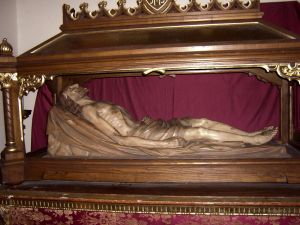The first church of Piazza San Siro
A place of worship with over two thousand years of history
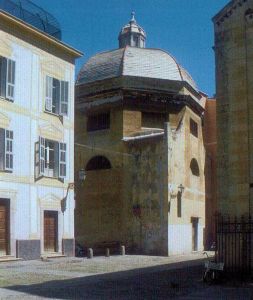 As said for the church of San Siro the area of the Piano in imperial times was a densely inhabited place also thanks to the passage of goods and people favoured by the nearby consular road Julia Augusta (Aurelia). Over the course of over a thousand years, the Baptistery has undergone so many alterations that it is extremely difficult to read its history and identify a precise chronology.
As said for the church of San Siro the area of the Piano in imperial times was a densely inhabited place also thanks to the passage of goods and people favoured by the nearby consular road Julia Augusta (Aurelia). Over the course of over a thousand years, the Baptistery has undergone so many alterations that it is extremely difficult to read its history and identify a precise chronology.
During the campaign of archaeological excavations in 1950 and 1951 and later in 1960, under the direction of Prof. Nino Lamboglia of the Institute of Ligurian Studies, important traces and signs have been found, from the imperial age to the XVII century.
In the manuscript "Sacro e vago Giardinello" (Archivio Vescovile di Albenga, vol. III, p. 537 can. Paneri), there is mention of this church:
« Almost adjacent to the so-called Collegiate Church, a new building of vague architecture can be seen in the elevation, to which the divine flock has been for many centuries in the rustic style, as can be seen in an ancient marble vase in the middle of it. It was resolved to give a modern form to be used for the Baptistery as it was in the past, and since it was to receive the Holy Baptism in it, they dedicated it to the patronage of the great Baptist; it holds the Choro a' tramontana and brings to' mezo giorno, of quadrangular architecture with a vault with a cube in the mezo, and three Altars in the frontiers to erase the sins with the celebration of the holy sacrifices; It was blessed in 1634 on 8th June by Canon Pietro Giogredo Gazzono with the license of the Ordinary with the assistance of the Clergy, Podestà and Consegio, and celebrated the Holy Mass on the day of the Holy Holder.
This Church (as far as we have been told), being almost completely destroyed because of the antiquity, we saw on our first visit that it was begun to be restored and built by the Community, which we hope to see as soon as possible, remaining a member of the above-mentioned Collegiate Church, where in ancient times there was the sacred fountain, where the Holy Baptism was received from the children ».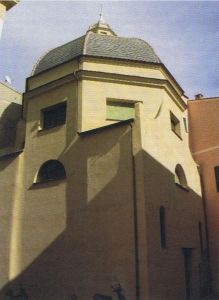 The Baptistery buildingIn a few words the description of this building corresponds to the present building as we know it.
The Baptistery buildingIn a few words the description of this building corresponds to the present building as we know it.
We also have news of the previous church when: « The year 1505 of Decembre was founded by various details of the fameglia de Palmari of the place of St. Paul. In this church there was a Capellania endowed with the sum of 975 lire and they were elected Patron Saints by the aforementioned, Lodisio, and Michaele de Palmari in their lifetime, and after them, some of them, older than the said fameglia, were obliged to celebrate a daily Mass at the Capellano pro tempore, There being no just impediment, however, or true with permission of said Patrons, on pain of losing the income for the time, which will not be served, to be applied to the reparation of it Capella in elected soda, and in the festive days assist in the Church of S. Siro con gli altri Pretti alla celebratione de Divini Officii a' detta elettione, ecome più più diffusamente appare dall'Instromento ricevuto dal fu M. Antonio Bottino notaro l'anno e giorno soletti, quale fu essibito nelli atti della Corte Episcopale, ne quali anche al presente si conserva nella filza dell'anno 1608 ».
II which means that the Palmari nobles took care of the church and obtained the right to bury their family members, a right that they maintained for some centuries until the end of 1700.
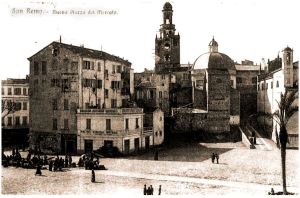
Some other written traces on this church are there and take us back another four hundred years when in July 1123, in a garden outside the walls, near the church of S. Giovanni, under a walnut tree, the Genoese Bishop Sigifredo, and Oberto, Count of Ventimiglia, in the presence of many boni homines from Genoa and Ventimiglia and (as the document says) the whole population of San Romolo, agreed as arbitrators, elected by the two parties.
It was a question of putting an end to the issue which, although it had already been the subject of Count Oberto's sentence thirteen years earlier, had however arisen again between the Provost Villano and his canons on the one hand and the men of the Castle of San Romolo on the other.
The Prepository demanded three quarters of the sharecropping of the entire income of the whole territory of San Romolo, which, he said, was fuit sancti sili and showed the libellum for Teodulfunt ianuensem episcopum to prove his right for the figs, for the citrus fruits, for the other species of trees, which prevented the land from giving product, (of blade), for all the feuds and for the blade of the whole territory. (see: Illustration of ancient documents referring to the Castle of San Romolo - Antonio Canepa - Albenga 1935).
In the precious volume "Excavations and discoveries in the Baptistery of Sanremo" Rivista Ingauna and Intemelia you can find many news and references that help to understand the succession of constructions in the various periods, which are summarized here and listed as archaeological levels:
- Level IV - Imperial Roman Age
- Level III - High-medieval era
- Level II - Late Medieval period after the XIIth century
- Level I - Post-XV century era
From this great mass of traces and clues we can say that it is more than two thousand years that man has frequented and left traces of his work in these 150 square metres of Matutian soil.
The traces of a high medieval wall placed in parallel with the remains of the Proto-Romanesque church under the pillar supporting the bell tower (as already illustrated in the page dedicated to the Basilica), could suggest a complex of parallel basilicas as in Albenga. We do not consider it useful for our narrative to delve into archaeological and historical details here, but we limit ourselves to highlighting how the history of
We do not consider it useful for our narrative to delve into archaeological and historical details here, but we limit ourselves to highlighting how the history of 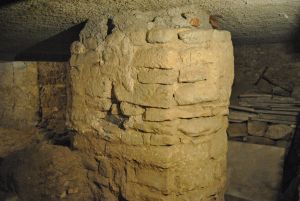 Sanremo originates from this place called the Baptistery. It only remains for us to highlight how the excavations are still visible and unfortunately not visitable, even if with little could make them usable. Column, underground find It would be a nice way to honor all those ancient visitors who have left a tangible sign of their work and their faith.
Sanremo originates from this place called the Baptistery. It only remains for us to highlight how the excavations are still visible and unfortunately not visitable, even if with little could make them usable. Column, underground find It would be a nice way to honor all those ancient visitors who have left a tangible sign of their work and their faith.
During the excavations, carried out between 1950 and 1960, various layers of pavement dating back to the medieval period have been identified, often crossed over each other, with areas for burial. The discovery of a circular room, which probably served for the fusion of the bells, a stretch of road dating back to the Roman period, a stone worked with a cologne, some burials and a portion of terracotta flooring, is significant.
The documents tell us about the Baptistery
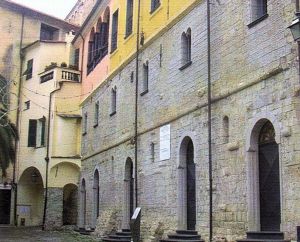 The first document attesting the presence of a church dedicated to St. John the Baptist in the area of the present day Piano dates back to 1123, the year in which the above mentioned deed was stipulated under a walnut tree in a vegetable garden located behind the church, a vegetable garden that had already become a square in 1164 and therefore a real "cloister" in 1210, at the same time as the presbytery was set up.
The first document attesting the presence of a church dedicated to St. John the Baptist in the area of the present day Piano dates back to 1123, the year in which the above mentioned deed was stipulated under a walnut tree in a vegetable garden located behind the church, a vegetable garden that had already become a square in 1164 and therefore a real "cloister" in 1210, at the same time as the presbytery was set up.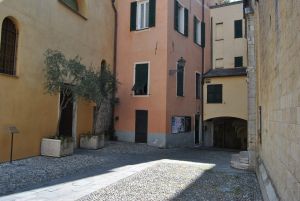 This area then took the name of "Resettu" and was later used as a cemetery and support structure for the primitive church of San Giovanni, which, in the period between the 12th and 13th centuries, did not have the current central plan, but developed over a nave and two aisles, while the bases of the shaped pillars dating back to this phase are still clearly visible in the area subject to the excavation campaign.
This area then took the name of "Resettu" and was later used as a cemetery and support structure for the primitive church of San Giovanni, which, in the period between the 12th and 13th centuries, did not have the current central plan, but developed over a nave and two aisles, while the bases of the shaped pillars dating back to this phase are still clearly visible in the area subject to the excavation campaign.
It seems, however, very probable that the original title of the Baptist can be traced back to the Genoese archiepiscopal dominion over the Matuan territory until its transfer to Oberto Doria and Giorgio De Mari by Archbishop Jacopo da Varagine in 1297.
It should also be noted that, in addition to the series of pillars placed underground, a fragment of the medieval building located on either side of the current entrance is still visible today, where the masonry is in regular rows, much more refined than the pillars, so much so that perhaps it could also be a later arrangement.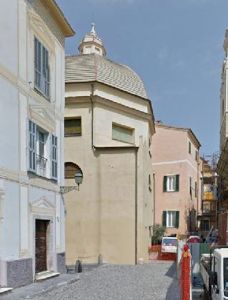 At the beginning of the 16th century the sacred building was completely rebuilt with a Greek cross plan inspired by the Renaissance and probably for baptismal
At the beginning of the 16th century the sacred building was completely rebuilt with a Greek cross plan inspired by the Renaissance and probably for baptismal 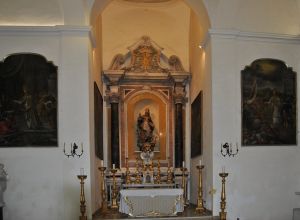 purposes. It was also supported by the foundation of a chaplaincy in 1505 by the Matuzian Palmari family, with the possibility of burial of members of the family. In the first half of the seventeenth century, the Baptistery was built as it is today, and its final arrangement had already been underway since 1576.
purposes. It was also supported by the foundation of a chaplaincy in 1505 by the Matuzian Palmari family, with the possibility of burial of members of the family. In the first half of the seventeenth century, the Baptistery was built as it is today, and its final arrangement had already been underway since 1576.
The building then underwent a series of profound renovations with a typical baroque style, such as the elimination of the southern and western sectors of the Greek cross church and the probable raising of the dome, with two asymmetrical side apses obtained from two arms of the previous church.
In the early days after the consecration, which took place in 1634, the old baptismal font must also have been present in the new sacred building, but it has never been found again.
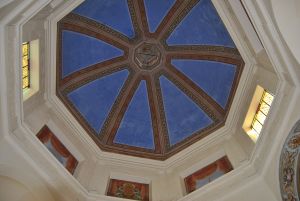 During the 17th century the church also had three altars, whereas today there is only one altar.
During the 17th century the church also had three altars, whereas today there is only one altar.
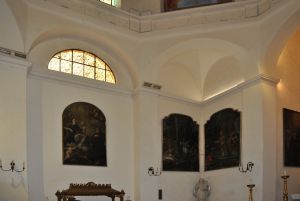 The building site was also used to house a structure for the fusion of a bell, in a period of time before the 17th century.
The building site was also used to house a structure for the fusion of a bell, in a period of time before the 17th century.
The internal structure of the Baptistery certainly looks much more spacious than it might seem from the outside and consists of a high dome on a polygonal tiburium, the dome a main chapel in front of the entrance and a chapel on the right side from where you access, through a metal staircase, the archaeological area below the floor.
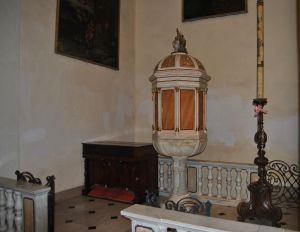
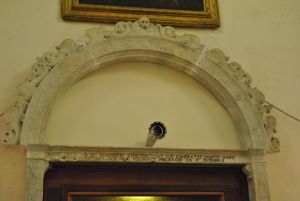 Until the last restoration works inaugurated on 18th May 1966, the altar that housed the baptismal font was still bounded by a wrought iron gate of excellent workmanship and by an artistic marble architrave finely sculpted with decorative elements inherent to the practice of the suffrage of the deceased, all works dating back to the 16th century.
Until the last restoration works inaugurated on 18th May 1966, the altar that housed the baptismal font was still bounded by a wrought iron gate of excellent workmanship and by an artistic marble architrave finely sculpted with decorative elements inherent to the practice of the suffrage of the deceased, all works dating back to the 16th century.
The architrave is placed as decoration of the entrance counter-façade, while the gate has been reused in the sacristies.
The vault above the ciboriumThe marble baptismal font with precious wooden ciborium dates back to the 17th century.
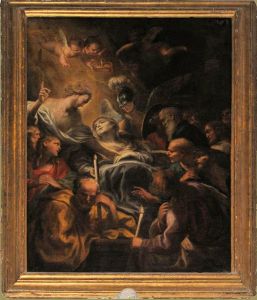
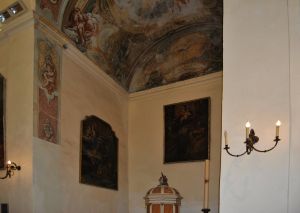 Inside the building the lighting is abundant thanks to the large openings and the walls house an authentic collection of works of art from sacred buildings in the city that no longer exist.
Inside the building the lighting is abundant thanks to the large openings and the walls house an authentic collection of works of art from sacred buildings in the city that no longer exist.
Above the entrance is the important painting of "La morte della Vergine" by Domenico Piola from Genoa (1627-1703), who interpreted Ligurian painting of the second half of the seventeenth century well in this painting.
In the centre of the left wall, under the window, we find the painting "Communion of Mary Magdalene" by Orazio De Ferrari (1606-1657), who created a particularly expressive work, rich in refined details and datable to the middle of the 17th century, from the Capuchin church in Porto Maurizio, dedicated to Mary Magdalene.
In the left corner on a pedestal you can see the marble statue of the Madonna del Carmelo, part of the homonymous altar already in the basilica before the restoration works of the 1930s. The work is linked to the famous model of the Genoese "Madonna delle Vigne".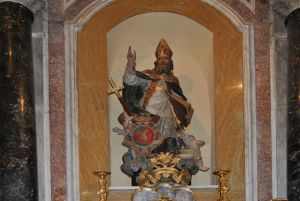 On the only altar, with its typically baroque appearance, there is a monumental statue that underwent a curious transformation, made for the Confraternity by the Minoja studio of Turin at the end of 1800, representing St. Germano, when the homonymous oratory was demolished in the mid 50s of the last century, the statue was renamed as St. Romulus and was added the coat of arms of the City of which he was the patron saint and the sword heraldic symbol of the Saint. In this way the statue changed name and place of exposure to the veneration of the faithful.
On the only altar, with its typically baroque appearance, there is a monumental statue that underwent a curious transformation, made for the Confraternity by the Minoja studio of Turin at the end of 1800, representing St. Germano, when the homonymous oratory was demolished in the mid 50s of the last century, the statue was renamed as St. Romulus and was added the coat of arms of the City of which he was the patron saint and the sword heraldic symbol of the Saint. In this way the statue changed name and place of exposure to the veneration of the faithful.
A valuable Allegory of Faith adorns the small door of the altar tabernacle which dates back to the XVII-XVIII century and was transferred from the nearby Basilica in 1938.
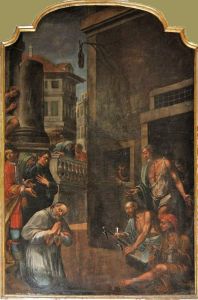 On the right wall is a painting by Maurizio Carrega (1737 - after 1819), depicting Saints Augustine and John of Nepomuk with a group of pilgrims, in which the accentuated dynamism of the scene, characterised by the particular realism of the pilgrims portrayed below, is particularly noteworthy.
On the right wall is a painting by Maurizio Carrega (1737 - after 1819), depicting Saints Augustine and John of Nepomuk with a group of pilgrims, in which the accentuated dynamism of the scene, characterised by the particular realism of the pilgrims portrayed below, is particularly noteworthy.
On the left wall there is a seventeenth-century canvas of evident devotional matrix, with Saint Lucy, Saint Anthony Abbot, Saint Anthony of Padua and Saint Bernardino of Siena, probably referable, according to its coat of arms and inscription, to a disappeared "chapel of the Ghirardi heirs".
Another devotional, but eighteenth-century work follows, depicting the Madonna and Child Jesus and two saints, perhaps identifiable with Crispino and Crispiniano, patrons of shoemakers, a guild that must surely have had numerous affiliates in the Sanremo of the time.
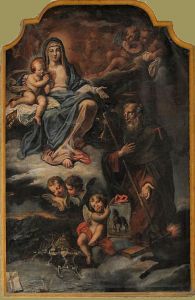 In the baptismal area there is a canvas with the Madonna and Child Jesus and Saint Anthony Abbot, an original image dating back to 1651, to which other figures
In the baptismal area there is a canvas with the Madonna and Child Jesus and Saint Anthony Abbot, an original image dating back to 1651, to which other figures 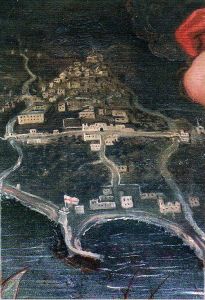 were added during the following century.
were added during the following century.
In the same painting, below, there is a precise view of the Sanremo of 1651, in which the main buildings of the city are clearly recognisable.
On the opposite side there is a large Guardian Angel dating back to the eighteenth century.
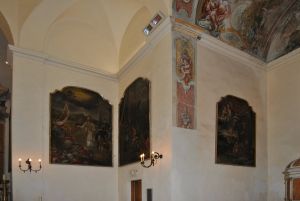
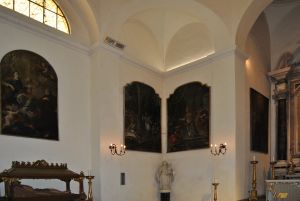 Episodes from the life of St. Germano can be seen on all the walls of the building and come from the adjacent and no longer existing Oratory. They are large paintings, all of equal size, made by an unknown local painter active between the seventeenth and eighteenth centuries, who painted some events taken from the stories of St. German of Auxerre.
Episodes from the life of St. Germano can be seen on all the walls of the building and come from the adjacent and no longer existing Oratory. They are large paintings, all of equal size, made by an unknown local painter active between the seventeenth and eighteenth centuries, who painted some events taken from the stories of St. German of Auxerre.
In the sequence the artist wanted to represent above all crowded and realistic scenes, with particular attention to the grandeur of the miracles performed by the saint. The subjects 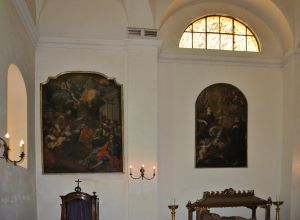 represented in succession in the series are from left to right: Side walls with paintingsSan Germano disputes about the possibility of performing miracles, preaching against heresies; St. Germano resurrects a man; St. Germano heals a young man on the edge of the harbour; St. Germano frees prisoners and St. Germano hunts down the Turkish army.
represented in succession in the series are from left to right: Side walls with paintingsSan Germano disputes about the possibility of performing miracles, preaching against heresies; St. Germano resurrects a man; St. Germano heals a young man on the edge of the harbour; St. Germano frees prisoners and St. Germano hunts down the Turkish army.
The latter subject is also characterised by a historical error, since, in reality, the saint had helped the Britons to drive out the Pitti, a population of present-day Scotland, but there was no knowledge of the latter in Sanremo and therefore the choice had fallen on the Turks, historical enemies of the city and of the entire Riviera di Ponente.
A presence which, however, is not part of the antiquity of the building but which can be clearly seen is in Theca with the Deposed Christ carved in wood, of the South Tyrolean school, is instead of the 50s of the 1900's and was purchased by the parish priest Pasquale Oddo in Val Gardena.
(sources: text Ernesto Porri; image sources: personal archives)





